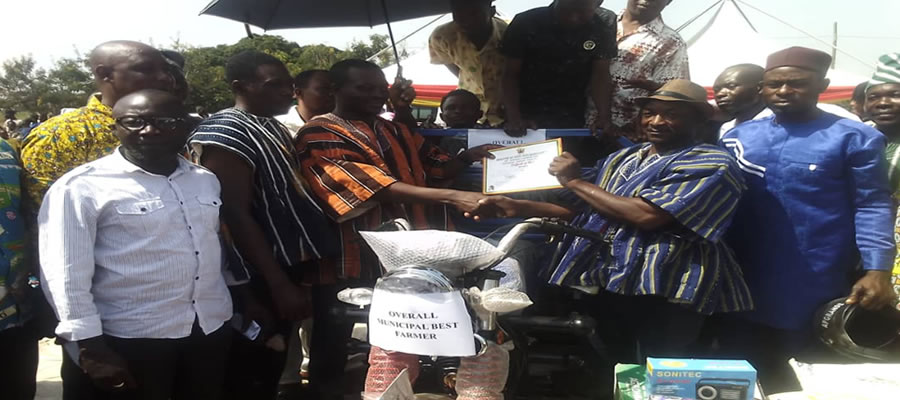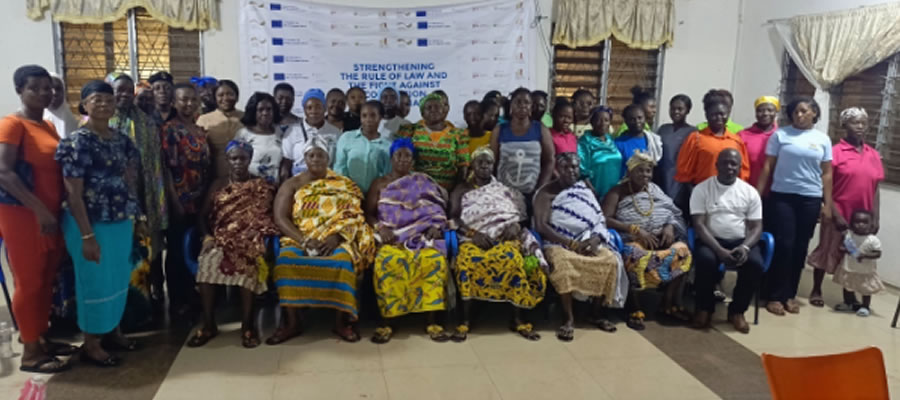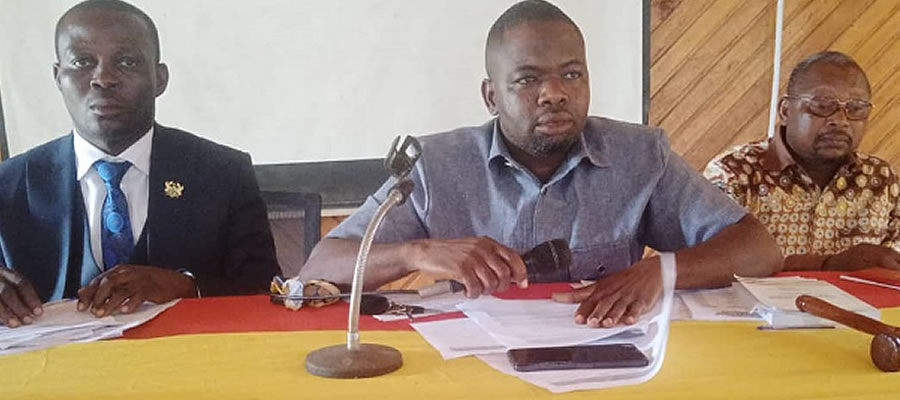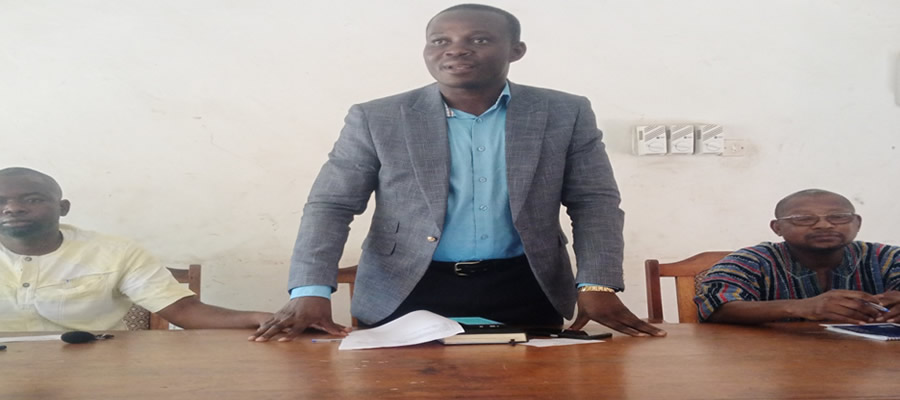

This chapter seeks to harmonize the issues or needs and aspirations identified from the field survey of the Atebubu-Amantin municipality with that of the municipality performance from the review of performance of the Agenda for Jobs with the Medium -Term Development Plan Policy Framework (2022-2025). The harmonized issues under the Agenda for Jobs and the MTDPF will be prioritized and subjected into the POCC analysis.
The development priorities identified under the various development dimensions under the Agenda for Jobs 2018-2021 include the following:
MAP.2 NATURAL RESOURCES IN THE ATEBUBU-AMANTIN MUNICIPALITY
Economic development
- Low-income levels
- High unemployment rate among the youth
- Revenue under performance due to leakage and loopholes, among others
- Low agricultural productivity
- Limited number of skilled industrial manpower
- Inadequate access to affordable credit
- Limited access to credit by SMEs
- Lack of dams for irrigation purposes
- Low application of technology especially among smallholder farmers leading to comparatively lower yields
- Poor storage and transportation systems
- Poor farm-level practices,
- High cost of conventional storage solutions for smallholder farmers
- Poor tourism infrastructure and Service
- Lack of market sheds for major towns in the municipality
- Inadequate favorable site for demonstrations
- Inappropriate siting of slaughter house leading to unwholesome meat
- Seasonal invasion of Fulani headsmen
- Inadequate AEA and Vet officers
- Lack of jobs for farmers during off season
- Difficulty in accessing tractor services
- Inadequate AEA quarters
Social development
- Low access to safe water
- Poor BECE/WASSE performance
- Inadequate furniture in various basic schools.
- Low levels of technical/vocational skills
- Low access to potable water supply
- Lack of teaching and learning materials especially at the basic level.
- Inadequate classroom blocks for both basic and senior high schools.
- Inadequate accommodation for teachers and health workers
- lack of decent office accommodation for municipal education directorate
- Low participation of females in learning of science, technology, engineering and mathematics
- Inadequate and inequitable access to education for PWDs and people with special needs at all levels
- Inadequate health facilities
- Increasing morbidity, mortality and disability due to communicable, non-communicable and emerging diseases
- Inadequate coverage of reproductive health and family planning services
- Poor agricultural practices which affect water quality
- Increasing demand for household water supply
- Inadequate maintenance of facilities
- Inadequate access to water services in urban areas
- High prevalence of open defecation
- Limited coverage of social protection programmes targeting children
- Low awareness of child protection laws and policies
- High incidence of children’s rights violation
- Inadequate care for the aged.
- Gender disparities in access to economic opportunities
- Inadequate and limited coverage of social protection programmes for vulnerable groups
- Inadequate opportunities for persons with disabilities to contribute to society
- Low participation of Persons with disability in decision making
- Poor living conditions of PWDs
- High levels of unemployment and under-employment
- Weak coordination of youth related institutions and programmes
- Inadequate and poor sports infrastructure
Infrastructure, Environment and Human Settlements
- Poor quality and inadequate road transport network
- Poor and inadequate maintenance of infrastructure
- Poor environmental sanitation
- High rate of environmental degradation
- High use of charcoal and fire wood
- Poor sanitation and waste management
- Undeveloped tourist sites and lack of infrastructure to support tourism development.
- Destruction of forests and farmlands,
- Weak natural resource management systems
- Improper disposal of solid and liquid waste
- Inadequate engineered landfill sites and waste water treatment plants
- Ineffective enforcement of noise regulations also continues to be a problem
- Inappropriate farming practices
- Over exploitation and inefficient use of forest resources
- Low institutional capacity to adapt to climate change and undertake mitigation actions
- Low economic capacity to adapt to climate change
- Inadequate inclusion of gender and vulnerability issues in climate change actions
- Loss of trees and vegetative cover
- Weak legal and policy frameworks for disaster prevention, preparedness and response
- Inefficiencies in the procurement, management and supervision of contracts
- Limited use of ICT as a tool to enhance the management and efficiency of businesses
- High dependence on wood fuel
- Difficulty in the extension of grid electricity to remote rural and isolated communities
- Limited awareness of energy conservation measures
- Poor management practices on construction sites
- Poor drainage system
- Scattered and unplanned human settlements
- Poor and inadequate rural infrastructure and services
- Poor infrastructure to catalyze agriculture modernization and rural development
Transparency, Accountability and Good Governance
- High incidence of armed robbery case
- Lack of Permanent office accommodation for substructures
- Inadequate security personnel
- Low women participation in decision making process.
- Lack of registration and documentation of government lands in the municipality.
DEVELOPMENT PROJECTIONS, ADOPTED GOALS, SUBGOALS OBJECTIVES AND STRATAGIES
Introduction
Significant gains were made by implementing GSGDA II. However, a number of problems and challenges have not been solved such as high unemployment rate, inadequate energy infrastructure to support modern energy services mentioned but a few as was revealed in the situational analysis. The Medium term Development Plan 2018 -2021 seeks to address some of these problems and challenges that have engulfed the nation and the Municipality in particular.
The chapter for that matter seeks to develop a goal as well as objectives and comprehensive strategies to dealing with these problems and challenges. To effectively handle the future issues, development projections were made. The chapter ended with a Logical Framework or Project Planning Matrix.
Municipal Goal
The overall goal of the Municipal is to become a hub of socio-economic activities that seek to improve the wellbeing of its citizenry through sustainable development.
Development Projections for 2018-2021
Development Projections are very crucial for the attainment of the Municipal goal. Knowledge relating to the current and future needs of the Municipal is very vital for informed decision making regarding the kind of interventions required by the Municipal for 2018-2021. It is for this reason that the population projections of the Municipal were made.
Population Projections
According 2010 population and housing census, the population of Atebubu –Amantin Municipal and growth rate stood at 105,938 and 3.0% respectively. This is projected to 130,290 in 2017.By the end of the plan implementation period, the population is expected to be 64541 using the exponential model Pt = Poert, where
Pt= the projected population,
Po = the population of the base year 2010,
r = the rate of population growth,
t = the time frame and
e =a constant with a value of 2.718
This was based on the following assumptions
a. Growth rate remains the same
b. Net migration remains constant
c. Age cohorts remains unchanged
d. Birth and death remains constant
However, the mathematical model was used for the yearly projections. This was done using the formula as follows:
Pt = Po (1 + rt)
Where:
Po is the population of the base year 2010
Pt is the population of the current year
r is the rate of population growth
t is the time frame.
Educational Projections
Assumptions
1. Nursery school will be a 2-Unit Classroom Block (Nursery 1 2)
2. All backlogs will be catered for in each year of the plan
From the table above it indicates that there is a backlog of 42 nursery schools (2 unit classroom blocks). Based on the projections from 2017 to 2021 there is a deficit of 59 nursery schools to be catered for within the planned period
Primary
One classroom for 40 children
Even though the table above indicates excess number of schools for the planned period, there is a deficit in terms of classroom. This implies that, additional 108 classrooms would to be constructed to meet the required number.
Junior High School
One classroom for 40 children
Using he Municipal population of 105938
1. Backlog will be provided timely to meet the population needs.
2. Lower order facilities would be upgraded to lessen burden on the Hospital.
3. Accessibility to facility’s catchment’s area would be standardised for fairly evenly distribution of service delivery.
Projections for Water
CWSA Standard for the Provision of Water Facilities
1. a population of between 150 and 300 for borehole,
2. 75 and 150 hand-dug wells and
3. 2000 and above(for small pipe systems)
WC: Water Closet (Drop hole)VIP: Ventilated Improved Pit KVIP: Kumasi Ventilated Improved Pit
STL: Septic Tank Latrine St: Seatter
Assumptions
1. A refuse skip would be 6 M3 container
2. Every household would patronise the skip.
3. Skips are dislodged daily.
4. Skips are strategically located in the urban communities.
Adopted Development Issues, Thematic Goals, Objectives and Strategies from NMTDPF. (2018-2021).
Policies have been formulated to highlight the vision for the Municipal and create the enabling environment within which the plan would be implemented. Specific strategies have been identified, and are expected to be used to achieve the objectives leading to the attainment of the ultimate goal.
Each thematic area has a specific goal and objective(s) intended to be achieved through carefully selected policies and strategies. It is expected that the successful implementation of these programmes and projects would yield the desired effect of an improved standard of living in the Municipal by 2021.
MONITORING AND EVALUATION
Monitoring and Evaluation
The process of monitoring is to enable the Municipal Assembly determine whether the required project inputs are being delivered on time and within cost. It is also to ascertain whether the inputs are being used as intended and are producing the desired results.
Likewise through the process of evaluation, the Assembly will be able to determine whether the desired impact of the project has been achieved, the causes of deviation if any, and how to counteract any unintended consequences. The process of evaluation therefore is to give a feedback that can lead to re-planning if necessary.
Monitoring is a process of collecting and analyzing data or events associated with the implementation of the policy, programme or project being implemented with the view to improving their management for the achievement of stated objectives. Resources are used in specific combinations to achieve a specific project result at a point in time.
This means that at each stage of the project, one must ensure that the required project inputs are being delivered on time used as intended and produced the desired result.
Secondly, every project has certain well defined objectives that address key development problems under the broad thematic areas. It is therefore very necessary and prudent that evaluation is done for each project to determine whether the impact has been felt or achieved, the causes of deviation if any, and how to counteract an unintended consequences. This is done through the process of evaluation. Evaluation therefore means a systematic, objective analysis of a plan/programme/ project performance, efficiency and impact in relation to its objective.
Monitoring and evaluation are necessary because unforeseen changes in the socio-economic situation of the MUNICIPAL as well as the political climate of the country and even certain international event could have both positive and negative effect on the plan. As a result of these, the plan needs constant monitoring to make sure that the necessary adjustments are made.
The MUNICIPAL ASSEMBLY will compile basic terms of reference for each project to include the list of references and their use over time, staff and their commitment and responsibilities, as well as budgeting. The planning guideline prepared by the NDPC for the preparation of Sectorial and MUNICIPAL Development Plan will be used to monitor and evaluate projects.
The MUNICIPAL ASSEMBLY needs to be able to compile basic terms of reference for each project to include the list of resources and their use over time, staff and their various commitment and responsibilities, as well as budgeting.
Evaluations will be conducted at specific points within the plan implementation period and a terminal evaluation will be done at the end of the implementation period.
The monitoring of the plan will be undertaken by the;
• Municipal Assembly through the Municipal Planning Coordinating Unit,
• The Sub-Committees of the Assembly.
• The Works Department and
• All the Decentralized departments.
• The Regional Coordinating Council
• The National Development Planning Commission
• Development Partners
Evaluation of the plan on the other hand will be carried out at specific intervals by the;
• Community members
• The MUNICIPAL Assembly
• Regional Coordinating Council
• The National Development Planning Commission
• Other external bodies that may be chosen for that purpose.
Date Created : 12/4/2018 8:10:33 AM












 facebook
facebook
 twitter
twitter
 Youtube
Youtube
 +233 593 831 280
+233 593 831 280 0800 430 430
0800 430 430 GPS: GE-231-4383
GPS: GE-231-4383 info@ghanadistricts.com
info@ghanadistricts.com Box GP1044, Accra, Ghana
Box GP1044, Accra, Ghana